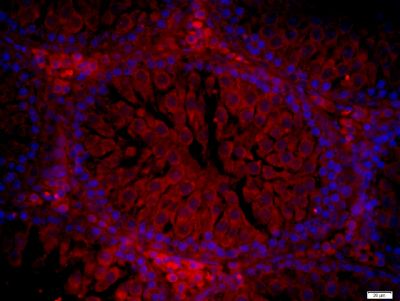NPW/Neuropeptide W Polyclonal Antibody
Purified Rabbit Polyclonal Antibody (Pab)
- SPECIFICATION
- CITATIONS
- PROTOCOLS
- BACKGROUND

Application
| IHC-P, IHC-F, IF, ICC, E |
|---|---|
| Primary Accession | Q8N729 |
| Reactivity | Rat, Bovine |
| Host | Rabbit |
| Clonality | Polyclonal |
| Calculated MW | 3 KDa |
| Physical State | Liquid |
| Immunogen | KLH conjugated synthetic peptide derived from human Neuropeptide W |
| Epitope Specificity | 33-55/165 |
| Isotype | IgG |
| Purity | affinity purified by Protein A |
| Buffer | 0.01M TBS (pH7.4) with 1% BSA, 0.02% Proclin300 and 50% Glycerol. |
| SUBCELLULAR LOCATION | Secreted |
| SIMILARITY | Belongs to the neuropeptide B/W family. |
| Important Note | This product as supplied is intended for research use only, not for use in human, therapeutic or diagnostic applications. |
| Background Descriptions | NPW is a 165 amino acid secreted protein that is cleaved into two chains: neuropeptide W-23 (also designated NPW23 or L8) and neuropeptide W-30 (also known as NPW30 or L8C). Both NPW neuropeptides activate G-protein coupled receptors in the central nervous system to enhance cortisol secretion. Highly expressed in lymphoblastic leukemia, colorectal adenocarcinoma, fetal kidney, trachea and substantia nigra, NPW is also found at low levels in placenta, ovary, testis and uterus. NPW functions in organization of neuroendocrine signals and is also thought to enhance food and water intake as well as stress responses. The gene encoding NPW maps to human chromosome 16p13.3. |
| Gene ID | 283869 |
|---|---|
| Other Names | Neuropeptide W, Preproprotein L8, hPPL8, Neuropeptide W-23, NPW23, hL8, Neuropeptide W-30, NPW30, hL8C, NPW, PPL8, PPNPW |
| Target/Specificity | Detected at high levels in the substantia nigra, fetal kidney and trachea; at lower levels in testis, uterus, ovary and placenta. Not detectable in many regions of the central nervous system. Also detected at high levels in lymphoblastic leukemia and colorectal adenocarcinoma. |
| Dilution | IHC-P=1:100-500,IHC-F=1:100-500,ICC=1:100-500,IF=1:100-500,ELISA=1:5000-10000 |
| Storage | Store at -20 ℃ for one year. Avoid repeated freeze/thaw cycles. When reconstituted in sterile pH 7.4 0.01M PBS or diluent of antibody the antibody is stable for at least two weeks at 2-4 ℃. |
| Name | NPW |
|---|---|
| Synonyms | PPL8, PPNPW |
| Function | Plays a regulatory role in the organization of neuroendocrine signals accessing the anterior pituitary gland. Stimulates water drinking and food intake. May play a role in the hypothalamic response to stress (By similarity). NPW23 activates GPR7 and GPR8 more efficiently than NPW30. |
| Cellular Location | Secreted |
| Tissue Location | Detected in cerebrospinal fluid and urine (at protein level) (PubMed:25326458, PubMed:36213313, PubMed:37453717) Detected at high levels in the substantia nigra, fetal kidney and trachea; at lower levels in testis, uterus, ovary and placenta. Not detectable in many regions of the central nervous system. Also detected at high levels in lymphoblastic leukemia and colorectal adenocarcinoma |

Thousands of laboratories across the world have published research that depended on the performance of antibodies from Abcepta to advance their research. Check out links to articles that cite our products in major peer-reviewed journals, organized by research category.
info@abcepta.com, and receive a free "I Love Antibodies" mug.
Provided below are standard protocols that you may find useful for product applications.
If you have used an Abcepta product and would like to share how it has performed, please click on the "Submit Review" button and provide the requested information. Our staff will examine and post your review and contact you if needed.
If you have any additional inquiries please email technical services at tech@abcepta.com.













 Foundational characteristics of cancer include proliferation, angiogenesis, migration, evasion of apoptosis, and cellular immortality. Find key markers for these cellular processes and antibodies to detect them.
Foundational characteristics of cancer include proliferation, angiogenesis, migration, evasion of apoptosis, and cellular immortality. Find key markers for these cellular processes and antibodies to detect them. The SUMOplot™ Analysis Program predicts and scores sumoylation sites in your protein. SUMOylation is a post-translational modification involved in various cellular processes, such as nuclear-cytosolic transport, transcriptional regulation, apoptosis, protein stability, response to stress, and progression through the cell cycle.
The SUMOplot™ Analysis Program predicts and scores sumoylation sites in your protein. SUMOylation is a post-translational modification involved in various cellular processes, such as nuclear-cytosolic transport, transcriptional regulation, apoptosis, protein stability, response to stress, and progression through the cell cycle. The Autophagy Receptor Motif Plotter predicts and scores autophagy receptor binding sites in your protein. Identifying proteins connected to this pathway is critical to understanding the role of autophagy in physiological as well as pathological processes such as development, differentiation, neurodegenerative diseases, stress, infection, and cancer.
The Autophagy Receptor Motif Plotter predicts and scores autophagy receptor binding sites in your protein. Identifying proteins connected to this pathway is critical to understanding the role of autophagy in physiological as well as pathological processes such as development, differentiation, neurodegenerative diseases, stress, infection, and cancer.


